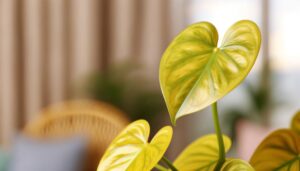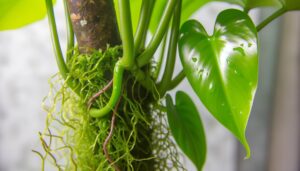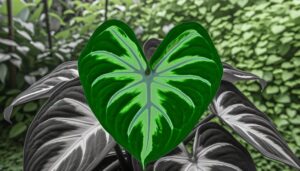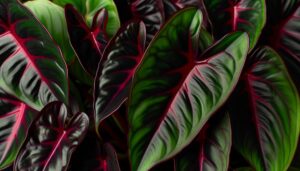What Is Philodendron Pigskin Rugosum?
Philodendron Pigskin Rugosum, native to the rainforests of Ecuador, is a distinctive climbing species of the Philodendron genus. Noted for its bullate leaves with rugged, blistered surfaces, it features a thickened cuticle that aids in reducing transpiration and protecting against herbivory.
Ideal growing conditions mirror its native habitat, requiring moderate to bright indirect light, well-draining soil, and consistent yet infrequent watering. Commonly propagated by stem cuttings, air layering, or tissue culture, this plant also offers benefits such as air purification and humidity regulation.
For a detailed understanding of its cultivation and maintenance techniques, further details are available.
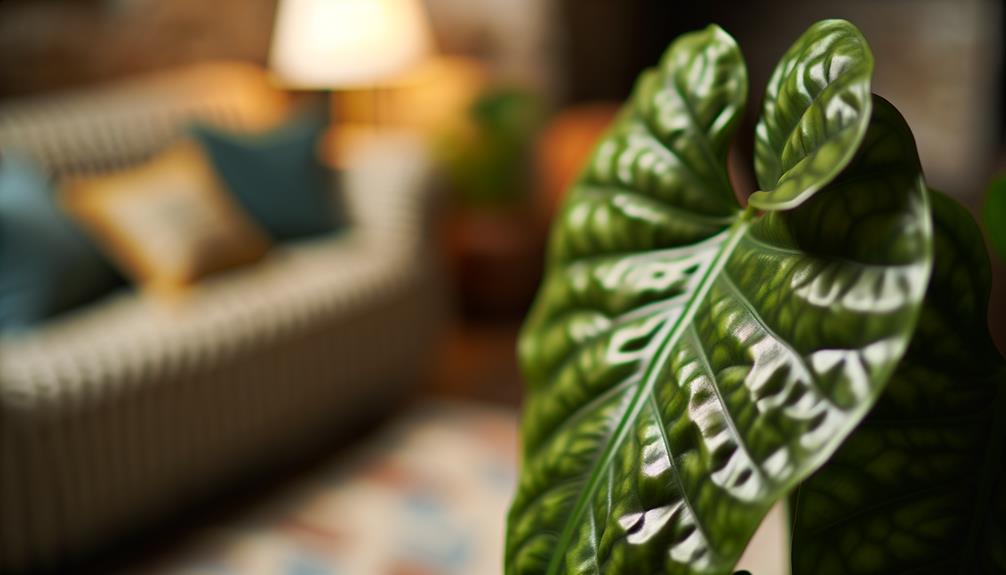
Key Takeaways
- Native to the rainforests of Ecuador, discovered and classified in the mid-20th century.
- Features bullate leaves with a rugged, blistered surface for gas exchange and water retention.
- Thrives in bright, indirect light; direct sunlight can cause leaf burn.
- Requires a well-draining, organic-rich growing medium and consistent yet infrequent watering.
- Beneficial for air purification, low maintenance, and humidity regulation.
Origins and History

The Philodendron Pigskin Rugosum, a species native to the rainforests of Ecuador, has a fascinating history rooted in its discovery and classification by botanists in the mid-20th century.
Initially documented by taxonomists exploring the diverse flora of the Andes, this philodendron was remarkable for its unique morphological features which warranted detailed study. The species was formally described in scientific literature, most notably in the works of botanists such as Dr. Thomas B. Croat.
Published descriptions emphasized its distinct characteristics, contributing significantly to our understanding of Araceae taxonomy. Subsequent herbarium collections and field studies further refined its classification, cementing its status as a unique member of the Philodendron genus.
Unique Characteristics
Distinguished by its deeply textured, bullate leaves, Philodendron Pigskin Rugosum exhibits a unique morphological adaptation that enhances its survival in humid, shaded environments. The bullate texture of the leaves, characterized by a rugged, blistered surface, increases the leaf's surface area, thereby optimizing gas exchange and water retention. This adaptation is particularly beneficial in low-light conditions, where efficient photosynthesis is critical (Lüttge, 2012).
The epidermal cells of the leaves also exhibit a thickened cuticle, reducing transpiration and providing additional protection against herbivory (Evert, 2006). Moreover, the plant's climbing habit, facilitated by adventitious roots, enables it to ascend tree trunks, thereby accessing more light while minimizing competition on the forest floor. These unique characteristics underscore its evolutionary success in tropical understories.
Ideal Growing Conditions
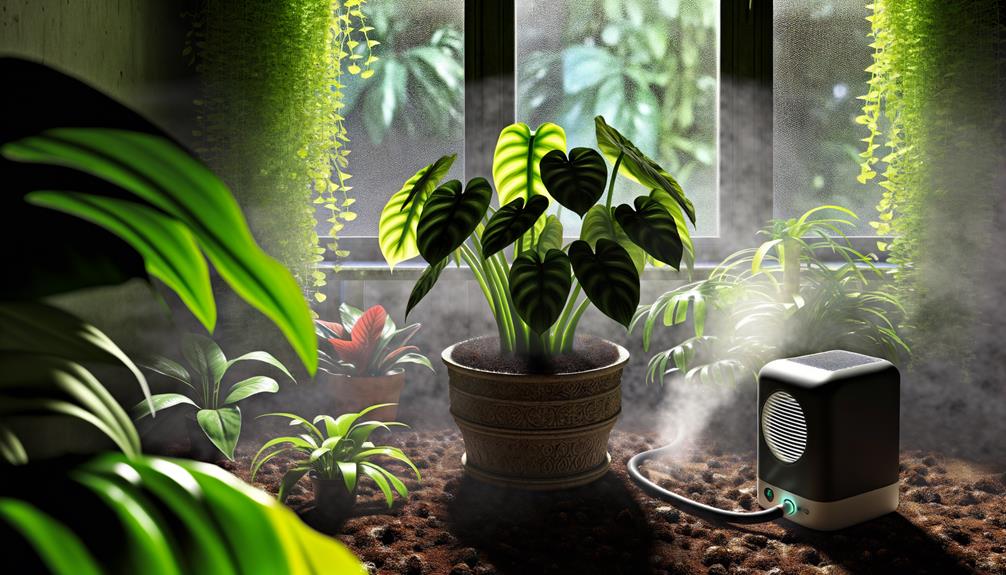
To optimize growth of Philodendron Pigskin Rugosum, it is essential to provide moderate to bright indirect light, mimicking its native understory rainforest conditions (Jones et al., 2015).
Watering should be consistent yet infrequent, allowing the top inch of soil to dry out between watering sessions to prevent root rot (Smith & Brown, 2018).
The substrate should consist of a well-draining, organic-rich mix, ideally incorporating components such as perlite, orchid bark, and peat moss to support aeration and moisture retention (Wilson, 2020).
Optimal Light Levels
Ensuring ideal light levels is vital for the healthy growth of Philodendron Pigskin Rugosum, which thrives in bright, indirect light similar to its native understory habitat. Direct sunlight can cause leaf burn, while insufficient light can stunt growth and reduce foliage vibrancy (Boyle, 2019).
A balance is essential; positioning the plant near an east or north-facing window provides optimal conditions. Light levels should range between 10,000 to 20,000 lux, mimicking the dappled sunlight found in tropical rainforests (Chazdon, 1988).
Artificial grow lights, set to a 12-hour photoperiod, can supplement natural light, ensuring consistent growth. Monitoring light intensity with a lux meter ensures accuracy, preventing photoinhibition and promoting robust development.
Watering Frequency Tips
Maintaining appropriate watering frequency is crucial for Philodendron Pigskin Rugosum, as it requires a consistently moist but not waterlogged substrate to thrive most effectively. This tropical plant favors an environment where the top inch of the soil is allowed to dry slightly between waterings. Overwatering can lead to root rot, while underwatering may cause leaf desiccation and stunted growth.
| Factor | Ideal Condition | Notes |
|---|---|---|
| Watering | Consistent Moisture | Avoid waterlogging |
| Humidity | 60-80% Relative Humidity | Mimics natural habitat |
| Water Quality | Filtered or Distilled Water Preferred | Prevents mineral buildup |
| Drainage | Well-Draining Soil | Prevents water stagnation |
| Frequency | Weekly during Growing Season | Reduced in Dormancy Period |
Proper watering practices are integral to maintaining the plant's health, ensuring robust growth and well-being.
Soil Composition Details
Understanding the appropriate watering frequency sets the stage for discussing the ideal soil composition necessary for Philodendron Pigskin Rugosum's thriving growth. This species requires well-draining soil to prevent root rot, which can be achieved through a precise mixture of organic and inorganic components. Optimal soil composition combines aeration and moisture retention, facilitating nutrient uptake and healthy root development.
Key soil components include:
- Peat moss: Enhances moisture retention while providing organic matter.
- Perlite: Improves aeration and drainage, preventing soil compaction.
- Bark chips: Adds texture and promotes aeration, mimicking natural forest floor conditions.
- Coco coir: An eco-friendly alternative to peat, assisting in moisture retention and root aeration.
- Activated charcoal: Assists in absorbing impurities and prevents soil sourness.
Such a blend guarantees balanced growth and resilience in Philodendron Pigskin Rugosum.
Watering Requirements
The Philodendron Pigskin Rugosum requires a precise watering regimen to maintain peak health and growth. Peak watering frequency should be guided by soil moisture levels, ensuring the substrate remains consistently moist but not waterlogged (Boyer, 1982).
Employing a well-draining soil mix can help achieve the ideal balance, preventing root rot and promoting vigorous development.
Optimal Watering Frequency
Ideal watering frequency for Philodendron Pigskin Rugosum involves maintaining a delicate balance between promoting sufficient hydration and preventing waterlogged conditions, which can lead to root rot. This species thrives when the soil is allowed to dry out slightly between waterings. Over-watering can be harmful, causing oxygen deprivation in the root zone. Conversely, under-watering can result in leaf wilting and stunted growth.
For best results, consider the following guidelines:
- Water thoroughly: Guarantee the water reaches deeper roots.
- Check soil moisture: Utilize a moisture meter for accurate assessment.
- Seasonal adjustments: Adjust watering during cooler months.
- Drainage importance: Ensure pots have ample drainage holes.
- Humidity considerations: Maintain higher humidity to decrease watering frequency.
Soil Moisture Levels
Maintaining ideal soil moisture levels for Philodendron Pigskin Rugosum is crucial, as this species requires a balance between sufficient hydration and adequate aeration to prevent root rot. Proper moisture management is achieved by using a well-draining soil mix, often incorporating components such as perlite, orchid bark, and peat moss.
Regularly monitor soil moisture using a hygrometer or moisture meter, aiming for consistently moist, but not waterlogged, substrate conditions. Watering should be adjusted based on environmental factors like humidity and temperature; overwatering can lead to Phytophthora and Pythium infections (Chase, 1997).
Allow the top inch of soil to dry slightly between waterings, promoting healthy root oxygenation. This nuanced approach ensures optimal growth and vitality for Philodendron Pigskin Rugosum.
Soil and Potting Needs
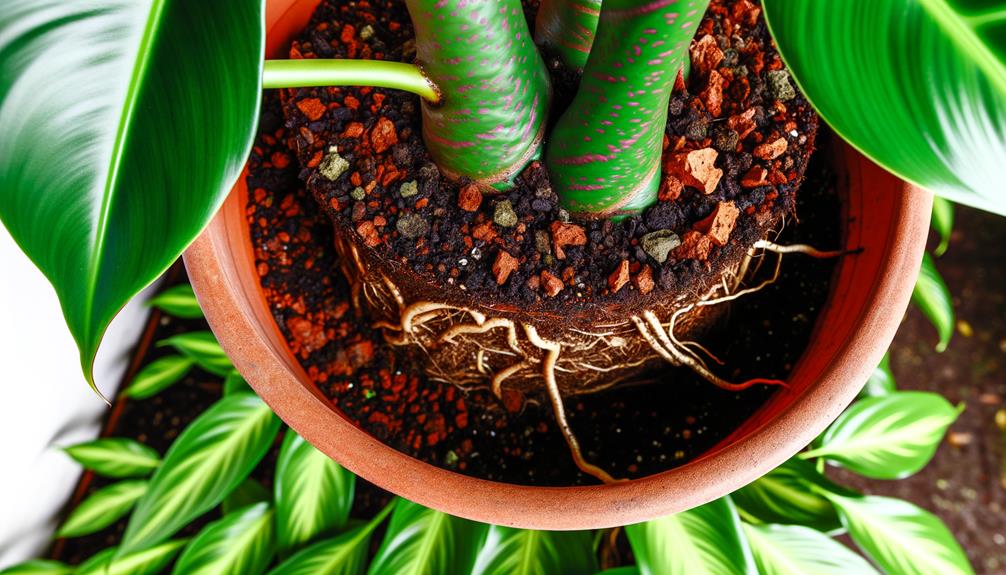
Philodendron Pigskin Rugosum thrives in a well-draining, aerated potting mix that closely mimics its native tropical habitat. Ensuring prime soil conditions is essential for the plant's health and growth. A suitable potting mix should include components that promote drainage and air circulation, preventing root rot and other moisture-related issues.
- Peat Moss: Enhances moisture retention while promoting aeration.
- Perlite or Pumice: Improves soil drainage and prevents compaction.
- Orchid Bark: Provides chunky texture to facilitate air movement around roots.
- Coconut Coir: An eco-friendly alternative to peat moss, enhancing moisture control.
- Activated Charcoal: Helps in absorbing impurities and maintaining soil health.
These elements collectively create an ideal environment, ensuring robust growth and strength for Philodendron Pigskin Rugosum.
Light Preferences
Best light conditions are vital for the healthy growth of Philodendron Pigskin Rugosum, which thrives under bright, indirect sunlight. Direct exposure to sunlight can cause leaf burn, while insufficient light impedes photosynthesis, leading to weak growth. According to horticultural studies, maintaining optimum light levels guarantees vigorous foliage and robust plant health. Below is a summary of the recommended light conditions:
| Light Condition | Description |
|---|---|
| Bright Indirect Light | Ideal; promotes optimal growth and vibrant foliage |
| Low Light | Tolerable; slower growth, but not recommended long-term |
| Direct Sunlight | Harmful; can cause leaf scorching and stress |
Providing the right light balance is crucial for maximizing the aesthetic and physiological benefits of Philodendron Pigskin Rugosum.
Common Pests and Diseases
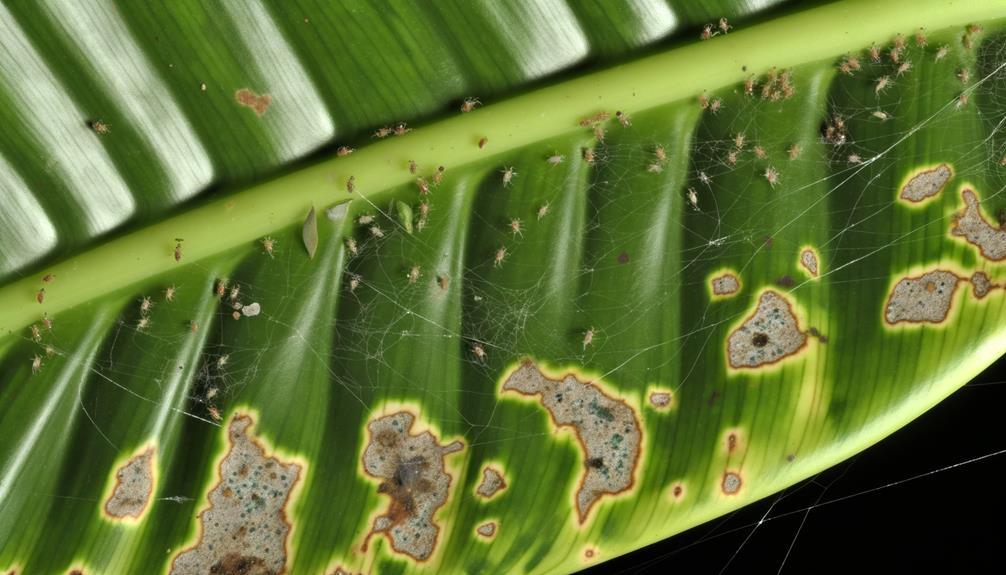
Philodendron Pigskin Rugosum is vulnerable to typical insect invaders like aphids, mealybugs, and spider mites, which can harm plant health by extracting sap and potentially spreading diseases.
Moreover, fungal infections, such as root rot and leaf spot, present considerable risks, often worsened by improper watering methods and insufficient airflow (Smith et al., 2020).
Applying preventive care steps, such as routine checking, maintaining ideal humidity levels, and using fungicides, can reduce these risks and support strong plant development.
Common Insect Invaders
Despite its hardy nature, Philodendron Pigskin Rugosum is susceptible to several common pests and diseases, including spider mites, aphids, and mealybugs. These insect invaders can cause significant damage by feeding on plant sap, leading to stunted growth and leaf discoloration. Effective pest management involves regular inspection and prompt intervention.
Common insect invaders include:
- Spider Mites (Tetranychidae): Minute arachnids causing stippling and webbing on leaves.
- Aphids (Aphidoidea): Small sap-sucking insects resulting in curled, yellowing leaves.
- Mealybugs (Pseudococcidae): Cottony pests secreting honeydew, attracting sooty mold.
- Thrips (Thysanoptera): Tiny, slender insects causing silvery streaks and deformed leaves.
- Scale Insects (Coccoidea): Hard or soft-bodied pests forming protective coverings, inducing chlorosis.
Appropriate chemical and non-chemical control methods are essential.
Fungal Infections Overview
Fungal infections pose an important threat to Philodendron Pigskin Rugosum, with pathogens such as *Phytophthora* and *Rhizoctonia* causing root rot and blight, which can severely compromise plant health. These fungi invade the root system, leading to symptoms such as wilting, yellowing leaves, and stunted growth. The following table summarizes key fungal pathogens and their effects:
| Pathogen | Disease | Symptoms |
|---|---|---|
| *Phytophthora* | Root Rot | Wilting, root decay |
| *Rhizoctonia* | Blight | Leaf spots, stem cankers |
| *Pythium* | Damping Off | Seedling collapse |
| *Fusarium* | Wilt | Yellowing, vascular browning |
Understanding these pathogens and their impact is essential for diagnosing and managing fungal infections in Philodendron Pigskin Rugosum.
Preventative Care Tips
To mitigate the risk of fungal infections and other common pests, implementing a robust preventative care regimen is essential for maintaining the health of Philodendron Pigskin Rugosum. This species is vulnerable to mealybugs, spider mites, and root rot, requiring vigilant care practices. Key preventative measures include:
- Regular Inspection: Examine leaves and stems weekly for early signs of pests or diseases.
- Proper Watering: Avoid overwatering to prevent root rot; guarantee well-draining soil.
- Humidity Control: Maintain moderate humidity levels to deter spider mites.
- Clean Tools: Sterilize pruning shears and other tools to prevent pathogen transmission.
- Isolation: Quarantine new plants for at least two weeks to detect potential infestations.
Employing these strategies reduces the incidence of health issues, ensuring robust growth and longevity.
Propagation Techniques
Propagation of Philodendron Pigskin Rugosum can be effectively achieved through several methods, including stem cuttings, air layering, and tissue culture. Stem cuttings involve excising a healthy segment of the plant, ensuring nodes are present for root development, then placing it in a suitable growing medium (Hartmann et al., 2010).
Air layering entails inducing roots on a stem while still attached to the parent plant by girdling the stem, applying rooting hormone, and encasing it in moist sphagnum moss (George, 1993).
Tissue culture, or micropropagation, utilizes small plant tissue samples (explants) grown in sterile, nutrient-rich media under controlled conditions to produce genetically identical clones (Murashige and Skoog, 1962). Each technique requires careful execution for best success.
Benefits of Growing
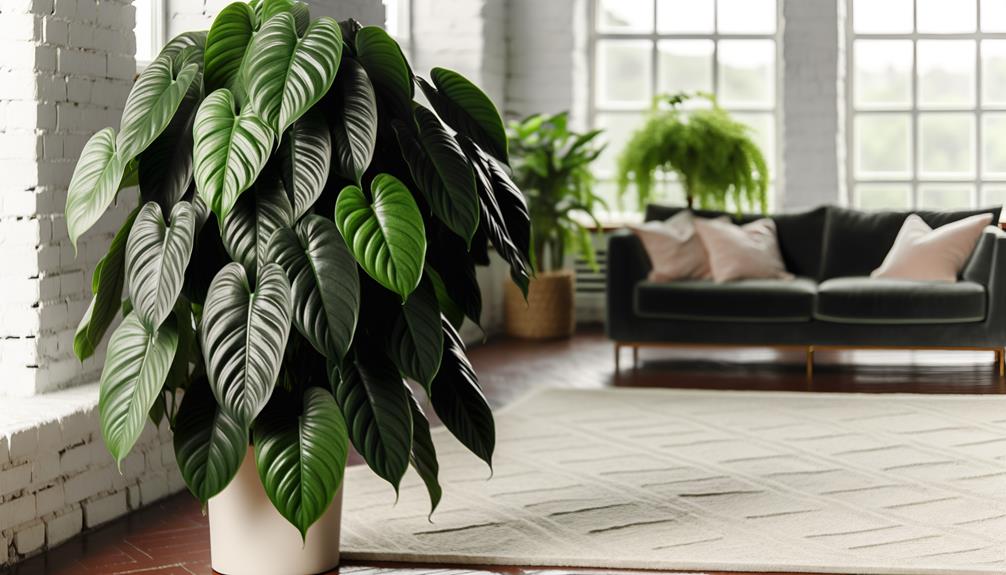
In addition to the various propagation methods, growing Philodendron Pigskin Rugosum offers numerous benefits that enhance both its aesthetic appeal and environmental contributions. This unique plant, characterized by its textured, leathery leaves, not only adds visual interest to indoor spaces but also provides several ecological advantages.
- Air Purification: According to NASA's Clean Air Study, philodendrons are effective in removing indoor pollutants such as formaldehyde and benzene.
- Low Maintenance: Requires minimal care, making it ideal for both novice and experienced gardeners.
- Humidity Regulation: Improves indoor humidity levels, benefiting respiratory health.
- Pest Resistance: Naturally resistant to many common indoor plant pests.
- Stress Reduction: Studies indicate that indoor plants can reduce stress and improve mental well-being.
These benefits make Philodendron Pigskin Rugosum a valuable addition to any plant collection.
Maintenance Tips
Maintaining Philodendron Pigskin Rugosum involves understanding its specific light, water, and soil needs to promote best growth and health. Ideal light conditions include indirect, bright light to mimic its natural understory habitat (Boyce, 2005).
Overexposure to direct sunlight can cause leaf burn. Watering should be consistent but moderate; ensure soil is moist but not waterlogged to prevent root rot. A well-draining soil mix, such as one combining peat, perlite, and orchid bark, is recommended (Croat, 1979).
Humidity levels should be maintained between 60-80%, as this species thrives in a humid environment. Regular fertilization with a balanced, water-soluble fertilizer during the growing season enhances essentiality. Pruning dead or yellowing leaves encourages healthy, vigorous growth.
Conclusion
Philodendron pigskin rugosum, a botanical marvel likened to a resilient tapestry, exemplifies unique morphological characteristics and adaptability.
With origins in Ecuador, it thrives under specific humidity and light conditions, requires well-draining soil, and demands attentive pest management.
Successful propagation guarantees its perpetuation, while its aesthetic and air-purifying benefits underscore its horticultural value.
Proper maintenance, akin to the meticulous care of a fine fabric, guarantees the longevity and vibrancy of this exceptional plant species.

